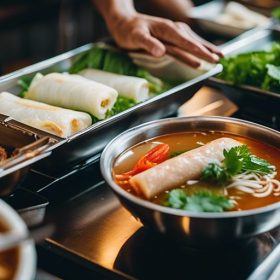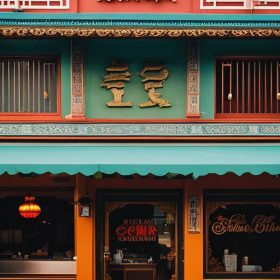Bun Vietnamese food is a popular and beloved cuisine that has a rich history and plays a significant role in Vietnamese culture. The word “bun” refers to rice vermicelli noodles, which are the main component of many traditional Vietnamese dishes. These dishes are known for their fresh and vibrant flavors, as well as their use of herbs and vegetables.
The origins of bun dishes can be traced back to ancient Vietnam, where rice was a staple crop. Rice vermicelli noodles were created as a way to make use of the abundant rice harvests. Over time, these noodles became a fundamental part of Vietnamese cuisine and were incorporated into various dishes.
Bun Vietnamese food holds a special place in Vietnamese culture and is often enjoyed as a family meal or during special occasions. It is a cuisine that brings people together and is deeply ingrained in the culinary traditions of the country.
Understanding the Different Types of Bun Dishes
There are several different types of bun dishes in Vietnamese cuisine, each with its own unique flavors and ingredients. Some of the most popular bun dishes include Bun Cha, Bun Bo Hue, Bun Rieu, and Bun Thit Nuong.
Bun Cha is a dish that originated in Hanoi and is made up of grilled pork patties served with rice vermicelli noodles, fresh herbs, and a dipping sauce. It is a flavorful and satisfying dish that showcases the balance of sweet, savory, and tangy flavors.
Bun Bo Hue is a specialty from the city of Hue in central Vietnam. It features beef broth flavored with lemongrass and shrimp paste, served with rice vermicelli noodles, beef slices, pork knuckles, and various herbs. This dish is known for its spicy and aromatic flavors.
Bun Rieu is a noodle soup dish that is made with a tomato-based broth and topped with crab or shrimp paste. It is typically served with rice vermicelli noodles, tofu, and various herbs. This dish is known for its rich and tangy flavors.
Bun Thit Nuong is a dish that consists of grilled pork served with rice vermicelli noodles, fresh herbs, and a fish sauce-based dressing. It is a popular street food dish in Vietnam and is loved for its smoky and savory flavors.
Common Ingredients Used in Bun Vietnamese Food
Bun Vietnamese food incorporates a variety of fresh and flavorful ingredients that contribute to its unique taste. Some of the common ingredients used in bun dishes include rice vermicelli noodles, fresh herbs, vegetables, meat or seafood, and various sauces and dressings.
Rice vermicelli noodles are a staple in bun dishes and provide a light and delicate base for the other ingredients. These noodles are made from rice flour and have a soft and chewy texture.
Fresh herbs such as mint, cilantro, Thai basil, and perilla leaves are essential in bun dishes as they add freshness and aroma to the dishes. These herbs are often served alongside the main dish and can be added to taste.
Vegetables such as bean sprouts, lettuce, cucumber, and pickled carrots and daikon radish are commonly used in bun dishes to add crunch and texture. These vegetables provide a refreshing contrast to the other ingredients.
Meat or seafood is another key component of bun dishes. Grilled pork, beef slices, shrimp, crab, or tofu are often used to add protein to the dish. These proteins are usually marinated or seasoned with various spices to enhance their flavor.
Sauces and dressings play an important role in bun dishes as they bring all the flavors together. Fish sauce-based dressings are commonly used in bun dishes to add a savory and tangy element. Other sauces such as hoisin sauce or chili sauce may also be added for additional flavor.
Tips for Pronouncing Bun Vietnamese Food Correctly
Pronouncing the names of bun dishes correctly can be a challenge for those who are not familiar with the Vietnamese language. Here are some common mispronunciations and tips for pronouncing bun dishes correctly:
– Bun Cha: The word “bun” is pronounced as “boon” and “cha” is pronounced as “chah.” So, it is pronounced as “boon chah.”
– Bun Bo Hue: The word “bun” is pronounced as “boon” and “bo hue” is pronounced as “boh hway.” So, it is pronounced as “boon boh hway.”
– Bun Rieu: The word “bun” is pronounced as “boon” and “rieu” is pronounced as “ree-uh.” So, it is pronounced as “boon ree-uh.”
– Bun Thit Nuong: The word “bun” is pronounced as “boon,” “thit” is pronounced as “teet,” and “nuong” is pronounced as “noo-uhng.” So, it is pronounced as “boon teet noo-uhng.”
To help with pronunciation, it can be helpful to listen to native speakers or ask for assistance from restaurant staff when ordering bun dishes.
How to Order Bun Vietnamese Food with Confidence
Ordering bun dishes at a Vietnamese restaurant can be an enjoyable experience if you know what to expect and how to navigate the menu. Here are some tips for ordering bun dishes with confidence:
1. Familiarize yourself with the menu: Take some time to review the menu and familiarize yourself with the different types of bun dishes available. Look for descriptions or pictures that can give you an idea of what each dish entails.
2. Ask for recommendations: If you’re unsure about what to order, don’t hesitate to ask the restaurant staff for recommendations. They can provide insights into popular dishes or suggest options based on your preferences.
3. Specify your preferences: When ordering, be sure to specify any dietary restrictions or preferences you may have. For example, if you’re vegetarian or have allergies, let the staff know so they can recommend suitable options or make necessary substitutions.
4. Be open to trying new flavors: Vietnamese cuisine is known for its bold and vibrant flavors. Don’t be afraid to step out of your comfort zone and try dishes that may be unfamiliar to you. You might discover new favorites!
5. Take your time: Vietnamese dining is often a leisurely affair, so take your time when ordering and savoring your meal. Enjoy the experience of trying new flavors and textures.
By following these tips, you can order bun dishes with confidence and fully enjoy the culinary delights of Vietnamese cuisine.
Decoding the Menu: Popular Bun Vietnamese Food Options
Vietnamese restaurants often have a wide variety of bun dishes on their menus. Here are some popular bun dishes and their descriptions:
1. Bun Cha: This dish consists of grilled pork patties served with rice vermicelli noodles, fresh herbs, and a dipping sauce. The pork patties are marinated in a combination of fish sauce, garlic, sugar, and other spices before being grilled to perfection. The dish is typically served with a side of pickled vegetables and a bowl of dipping sauce made from fish sauce, vinegar, sugar, garlic, and chili.
2. Bun Bo Hue: Originating from the city of Hue in central Vietnam, this dish features beef broth flavored with lemongrass and shrimp paste. It is served with rice vermicelli noodles, beef slices, pork knuckles, and various herbs. The broth is rich and spicy, thanks to the addition of chili oil and fermented shrimp paste.
3. Bun Rieu: This noodle soup dish is made with a tomato-based broth and topped with crab or shrimp paste. It is typically served with rice vermicelli noodles, tofu, and various herbs. The broth is tangy and flavorful, and the addition of crab or shrimp paste gives it a unique taste.
4. Bun Thit Nuong: This dish consists of grilled pork served with rice vermicelli noodles, fresh herbs, and a fish sauce-based dressing. The pork is marinated in a combination of fish sauce, sugar, garlic, and other spices before being grilled to perfection. The dish is typically garnished with crushed peanuts and served with a side of pickled vegetables.
These are just a few examples of the many bun dishes available at Vietnamese restaurants. Each dish has its own unique flavors and ingredients, making it a delight to explore the menu and try new dishes.
Accompaniments to Pair with Bun Vietnamese Food
When enjoying bun dishes, it is common to pair them with various accompaniments that enhance the flavors and textures of the meal. Here are some common accompaniments to bun dishes:
1. Fresh Herbs: Fresh herbs such as mint, cilantro, Thai basil, and perilla leaves are often served alongside bun dishes. These herbs add freshness and aroma to the meal and can be added to taste.
2. Bean Sprouts: Bean sprouts are commonly served as an accompaniment to bun dishes. They provide a crunchy texture and can be added to the dish for extra freshness.
3. Lettuce: Lettuce leaves are often used as a wrap for bun dishes. They can be filled with noodles, meat or seafood, herbs, and other toppings before being rolled up and eaten.
4. Pickled Vegetables: Pickled carrots and daikon radish are commonly served as a side dish or topping for bun dishes. They add a tangy and slightly sweet flavor that complements the other ingredients.
5. Lime Wedges: Lime wedges are often served alongside bun dishes to add a tangy and citrusy element. Squeezing lime juice over the dish can help to brighten the flavors.
These accompaniments can be added to the bun dish according to personal preference, allowing for a customized and balanced dining experience.
Etiquette Tips for Eating Bun Vietnamese Food
When enjoying bun dishes at a Vietnamese restaurant, it is important to observe proper dining etiquette. Here are some etiquette tips to keep in mind:
1. Use chopsticks and a spoon: Vietnamese cuisine is traditionally eaten with chopsticks and a spoon. Use the chopsticks to pick up noodles, meat or seafood, and other ingredients, and use the spoon to scoop up broth or rice.
2. Share dishes: Vietnamese dining is often a communal experience, so it is common to share dishes with others at the table. Take small portions from each dish and pass them around so that everyone can try a bit of everything.
3. Use serving utensils: When serving yourself from shared dishes, use the provided serving utensils rather than your own chopsticks or spoon. This helps to maintain hygiene and prevent cross-contamination.
4. Wait for others to start eating: It is polite to wait for everyone at the table to be served before starting to eat. This shows respect for others and allows everyone to enjoy the meal together.
5. Say “cheers” before drinking: In Vietnamese culture, it is customary to say “cheers” or “mot hai ba yo” before taking a sip of your drink. This is a gesture of goodwill and camaraderie.
By observing these etiquette tips, you can fully immerse yourself in the Vietnamese dining experience and show respect for the culture.
Health Benefits of Bun Vietnamese Food
Bun Vietnamese food is not only delicious but also offers several health benefits. The cuisine is known for its emphasis on fresh ingredients and the use of herbs and vegetables, which contribute to its nutritional value.
1. Nutrient-rich ingredients: Bun dishes often include a variety of vegetables, herbs, and proteins, providing a well-rounded meal that is rich in essential nutrients. Vegetables such as lettuce, bean sprouts, and pickled vegetables are high in vitamins and minerals, while herbs like mint and basil offer antioxidant properties.
2. Low in fat: Many bun dishes are relatively low in fat, especially when compared to other cuisines. Grilled meats or seafood are often used, which reduces the amount of added fats. Additionally, the use of fresh herbs and vegetables adds flavor without the need for excessive oil or butter.
3. High in fiber: Rice vermicelli noodles used in bun dishes are a good source of dietary fiber. Fiber is important for digestive health and can help regulate blood sugar levels and promote feelings of fullness.
4. Balanced flavors: Vietnamese cuisine is known for its balance of flavors, with dishes often incorporating sweet, savory, sour, and spicy elements. This balance not only makes the food enjoyable to eat but also helps to regulate appetite and prevent overeating.
5. Fresh ingredients: The emphasis on fresh ingredients in Vietnamese cuisine ensures that bun dishes are packed with vitamins, minerals, and antioxidants. Fresh herbs and vegetables are used abundantly, providing a range of health benefits.
By choosing bun dishes at Vietnamese restaurants, you can enjoy a delicious meal while also nourishing your body with wholesome ingredients.
Vegetarian and Vegan Options for Bun Vietnamese Food
For those following a vegetarian or vegan diet, there are several options available when it comes to bun Vietnamese food. Here are some vegetarian and vegan options for bun dishes:
1. Bun Chay: Bun Chay is a vegetarian version of Bun Cha that replaces the grilled pork patties with tofu or tempeh. The dish is served with rice vermicelli noodles, fresh herbs, and a vegetarian dipping sauce. It offers a similar flavor profile to the original dish but without the meat.
2. Bun Bo Chay: Bun Bo Chay is a vegetarian version of Bun Bo Hue that replaces the beef slices and pork knuckles with tofu or seitan. The dish is served with rice vermicelli noodles, vegetarian broth flavored with lemongrass and spices, and various herbs. It provides a satisfying and flavorful alternative to the meat-based version.
3. Bun Rieu Chay: Bun Rieu Chay is a vegetarian version of Bun Rieu that replaces the crab or shrimp paste with tofu or mushrooms. The dish is served with rice vermicelli noodles, vegetarian broth flavored with tomatoes and spices, tofu, and various herbs. It offers a tangy and flavorful experience without the use of animal products.
4. Bun Thit Nuong Chay: Bun Thit Nuong Chay is a vegetarian version of Bun Thit Nuong that replaces the grilled pork with tofu or seitan. The dish is served with rice vermicelli noodles, fresh herbs, and a vegetarian fish sauce-based dressing. It provides a smoky and savory flavor without the need for meat.
These vegetarian and vegan options allow those with dietary restrictions to enjoy the flavors and textures of bun Vietnamese food while still adhering to their chosen lifestyle.
Exploring the Regional Variations of Bun Vietnamese Food
Vietnam is a diverse country with distinct regional cuis ines. One of the most popular and beloved dishes in Vietnamese cuisine is bun, a type of noodle dish. However, bun can vary greatly depending on the region in Vietnam. In the northern region, bun cha is a famous dish that consists of grilled pork served with rice noodles and a side of herbs and dipping sauce. This dish is known for its smoky and savory flavors. In the central region, bun bo Hue is a specialty that features beef broth with rice noodles, beef slices, and various herbs and spices. This dish is known for its spicy and bold flavors. In the southern region, bun mam is a popular choice that includes fermented fish sauce broth with rice noodles, shrimp, pork, and various vegetables. This dish is known for its rich and complex flavors. Overall, exploring the regional variations of bun in Vietnam allows one to experience the diverse and unique flavors that each region has to offer.

Cuong Nguyen is a talented writer and experienced waitress at Vietnampalace.net, a renowned Vietnamese restaurant that offers an extensive menu of authentic Vietnamese cuisine. With a background in the competition of Vietnamese cuisine, Cuong brings a wealth of knowledge and expertise to the dining experience. From delicious pho dishes to fresh spring rolls, Cuong ensures that every meal is made with the freshest ingredients and authentic flavors.With exceptional service and a friendly atmosphere, Cuong takes pride in providing a memorable dining experience for every customer.
Whether you’re a vegetarian looking for options or a meat lover craving the flavors of traditional Vietnamese dishes, Cuong guarantees a delightful culinary adventure. So, visit Vietnampalace.net and let Cuong guide you through the tantalizing world of Vietnamese cuisine.



